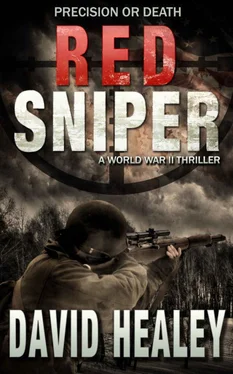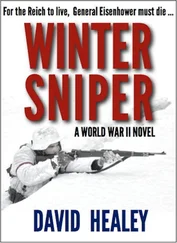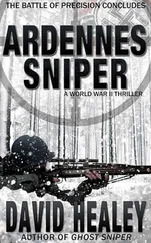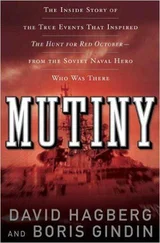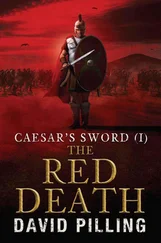“It looks like our boys caught a German sniper,” the Mink announced.
He was standing over a body in the bottom of a shell hole. The man was nearly naked, his trousers down to his knees and his shirt gone, and his torso was covered in cuts. But these were not shrapnel wounds—on closer inspection, it was apparent that he had been sliced and stabbed multiple times by bayonets—no single one of which would have been a killing wound. In the Soviet army, snipers were celebrated as specialized soldiers and heroes. However, German snipers were seen as sneaky, inhuman scum, and treated accordingly. The fast-moving Russians wouldn’t have bothered to torture just any soldier, and the fact that he was a sniper was evidenced by the scoped rifle, the muzzle of which had been jammed far up the German’s rectum.
“One less for us to worry about,” Barkov said.
The Mink knelt down beside the body. “Hey, this one is still alive, poor bastard. We should finish him off.” The Mink moved to shoot the German, but Barkov reached out to stop him.
“Death would be a mercy,” he said. “Let him suffer a while.”
The Mink grinned. “Of course. What was I thinking?”
They stayed in the shell hole for a few minutes, getting their bearings. The Mink went through the bloody rags that remained of the helpless sniper’s clothes and found some chocolate, which he shared with Barkov. They munched while the man lay there moaning.
From the sounds ahead, it was clear that the attack on Seelow Heights pressed forward. Some military genius had finally figured out that the searchlights were causing more harm than good, and one by one they blinked off, leaving the battlefield illuminated only by small burning fires. By then the damage was already done, however. Bodies blanketed the marshes and hills. Barkov couldn’t have known it then, but decades later, the skeletons of the dead would still be turning up whenever there was a heavy rain or a construction project in the vicinity.
The Russian strategy had been to overwhelm the Germans with sheer numerical superiority. For every two Russian soldiers mowed down, another one or two had gotten through the killing fields to make a direct attack on the German positions. Those numbers had been enough. Inexorably, foxhole by foxhole, the defenders of Seelow Heights were being defeated.
“Come on, we don’t want to miss any of the fun,” Barkov said, and together the two snipers trotted in the direction of Berlin, still many miles away.
High above Germany, the B-17 Flying Fortress left behind a white contrail as if someone had dragged a piece of chalk across the slate blue sky. The plane was just one of a squadron flying in formation. At the controls of the lead bomber was Harrison Whitlock IV, a 22-year-old first lieutenant who had left Harvard University in his junior year to join the Army Air Corps.
This was his fourteenth mission with the Lucky Girl , as the crew had decided to call the plane. It had cost Whitlock twenty bucks to get a private who had been an art student at Columbia to decorate the fuselage with a portrait of a buxom young woman with flowing red hair. She wasn’t based on anyone Whitlock or the other young crewmen had known outside of their fantasies, but she was just their sort of ideal girl—that is, all tits and ass and gratitude—that they wouldn’t have minded coming back to at the end of a mission. They liked to joke that they would make her one Lucky Girl, all right.
Maybe it was silly to be motivated by a girl straight out of a fantasy, but 27,000 feet up with German flak coming at you, you held on to what you could.
“Smooth air so far today,” said Chip Bronson, the co-pilot.
“Don’t jinx us,” said Whitlock, who was known for being easygoing, except when he took command of the Lucky Girl , at which time he became a hard ass. That was just fine with the nine other crew members aboard the Lucky Girl who put their faith in Whitlock to get them back home in one piece. Whitlock had done just that so far, but they were all well aware that sometimes a plane and its crew just drew the short straw when it came to luck, regardless of the girl on the fuselage.
They had seen it happen on their third mission, when the tail gunner shot a German fighter practically right out of the sky. They had all cheered on the intercom, but then watched in horror as the cartwheeling fighter slammed into another B-17. Silence had fallen as the B-17 plummeted to earth, too quickly for any parachutes to get out. Back on the ground, they never had talked about it.
“Not a bandit in sight,” Bronson said.
“What did I just say about jinxing us?”
Bronson smirked, clearly busting the pilot’s chops, and they flew on in silence. Whitlock had to admit that the job had gotten a little easier over the last few weeks. The Luftwaffe was mostly gone from the skies. Earlier in the air war, that had not been the case at all, and the German fighters had devastated the B-17 bombers.
For defensive purposes, it was critical to stay in formation. The fighter escorts did not have the range of the bombers, and so had to turn back as the bombers pressed deeper and deeper into German territory as the weeks progressed. That left the B-17s unprotected from the Messerschmitt fighters. However, it wasn’t for nothing that the American bombers were called Flying Fortresses. With an array of heavy machine guns, a B-17 created a defensive perimeter around itself. The Germans nicknamed the B-17s “Flying Porcupines” for good reason. There were weak points and blind spots, however, which was why it was critical to stay in position. The squadron’s formation enabled the planes to cover one another, thus creating a zone of defense around their bombers.
That was the theory, anyhow, and it all sounded good in flight school. Reality was a bit different. A German Me109 moved at more than four hundred miles per hour, fired 20 mm cannon rounds that left holes the size of a softball in a bomber’s thin skin, and flew circles around the lumbering B-17. In close air combat, it tested the limits of human reflexes to be able to swivel and fire at a target moving at that speed. To be sure, it took a young man’s reflexes. Whitlock used to do some trapshooting with his grandfather, Senator Harrison Whitlock II, and it had been hard enough to hit a clay pigeon with a 12-gauge shotgun. Compared to a German fighter, a clay pigeon now seemed like a slow, lumbering target. And the clay pigeon wasn’t shooting back.
It took a lot of firing, and a lot of luck, to knock a German fighter out of the sky. Fortunately, the B-17 made up for being slow by being tough. Lucky Girl could take an awful lot of abuse of the flying lead variety.
As they neared the target, bursts of flak began to claw the sky. Lucky Girl danced in the turbulence from the explosions. Whitlock tried not to think too much about what it would mean to take a direct hit. Until a few months ago, he had never heard of the word “flak,” which was a British interpretation of what the Germans called Flug Abarhr Kanone —anti-aircraft ordnance. Now he was all too aware of the word. Call it whatever you wanted—by any name it was nerve-wracking as hell.
The intercom crackled, and the navigator came on to give him an update.
“Hey Cap, we’re getting close.”
Whitlock glanced at his own map, which was more rudimentary than the navigator’s. He could see they were near the drop zone. He got the bombardier on the intercom.
“I’ll hold her steady,” Whitlock said. “You send the presents down the chimney.”
On this plane, there were several jobs going on at once. The navigator. The bombardier. The flight engineer. The radio operator. Four separate gunners, including the Sperry ball turret gunner, provided defense. And there was a co-pilot, in case Whitlock caught a piece of that flak, or became otherwise incapacitated. His own job was to get them to the target and back in one piece.
Читать дальше
